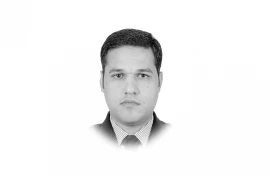
First, since a sustainable pro-poor growth requires structural changes in the economy, the market mechanism, alone, cannot be expected to achieve this objective. In an economy where the distribution of productive assets is highly unequal and where the institutional structure tends to direct state resources to the elite in the form of unearned incomes, the markets, as presently configured, will continue to generate increasing economic inequality. At the same time with the ‘entrepreneurial’ elite addicted to government subsidies and averse to innovation and risk, the savings rate will continue to remain low and there will be a continued inability to accelerate export earnings through a change in the export structure favouring high value-added items. Consequently, a stop-go pattern of aid dependent growth that typifies Pakistan’s economic history will persist.
The second proposition is that a change in the institutional structure needs to be initiated to provide access to productive assets, markets and high wage employment to all of the citizens, rather than just a few. Only such an opening up of the economy and the associated incentive structure will bring to bear the untapped potential of the people for sustaining growth. Only then, can a broad base be created for savings, investment, competition, efficiency and innovation. Such a change in the institutional structure demonstrably cannot be achieved by the market mechanism. Indeed, the last two decades of research on the subject shows that whether markets function efficiently or inefficiently and whether growth can be sustained or not, depends on the underlying institutional structure. It determines not only the range and intensity of competition but, through its incentive/disincentive structure, shapes the economic behaviour of individuals and organisations.
The third proposition is that in Pakistan the institutional structure through which efficient markets and sustained and equitable growth can be achieved, involves three initiatives: (i) Ownership rights over arable state land of about 2.6 million acres in five acre packages to poor tenants, which will transform 58 per cent of tenants into owner operators. This will give them both the incentive and ability to increase yields per acre and thereby, begin a new path of higher and more equitable agriculture growth. (ii) Establish large corporations, with equity owned by the poor and operated by professionals, in the fields of agriculture extension and technology, dairy products and telecommunications. (iii) Accelerated growth of small and medium-scale export oriented enterprises through public-private partnership for the establishment of common facilities centres would enable specialised fabrication, raw material banks and access over credit and markets.
The fourth proposition is that placing Pakistan on a new growth trajectory will require a new kind of planning. The plan would specify the necessary and sufficient set of institutional changes through a time-bound series of actions in both the spheres of governance and economy.
New institutional economics suggests that economic performance is fundamentally determined in the realm of the polity, because that is where rules that define institutions are determined. Accordingly, the path to sustained and equitable growth in Pakistan can begin in the legislature and governance, rather than in the market mechanism.
Published in The Express Tribune, May 23rd, 2011.

1736942026-0/fizza-(33)1736942026-0-165x106.webp)


1736941045-0/fizza-(32)1736941045-0-165x106.webp)






1732012115-0/Untitled-design-(14)1732012115-0-270x192.webp)
1736844405-0/Express-Tribune-(2)1736844405-0-270x192.webp)






COMMENTS (6)
Comments are moderated and generally will be posted if they are on-topic and not abusive.
For more information, please see our Comments FAQ